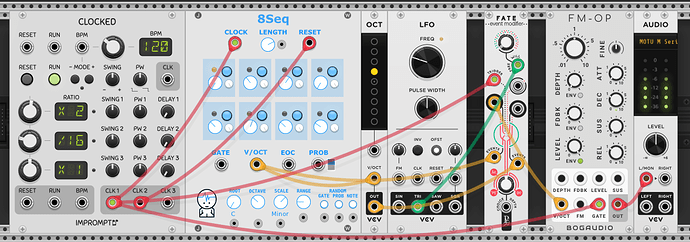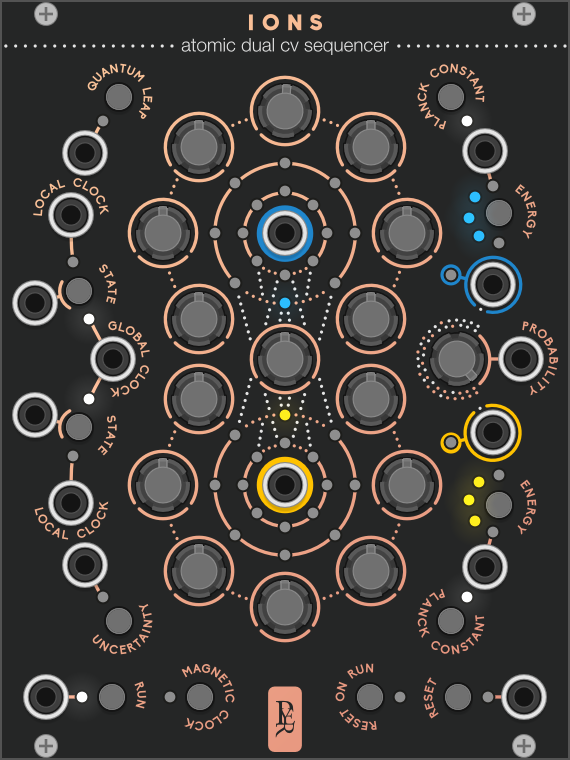Well you can replace the octave module in the example above with a completely separate sequencer. It’s fun to use two sequencers running completely different patterns and jumping between them.
Thank you! What an elegant and small solution! Will definitely make a selection for import from this.
I had a wire incorrectly placed. Now I understand the two sequences.
Like Auret, I immediately thought to add offsets to the V/Oct signal.
In Purf’s original post he stated he had an arpeggio, and I assumed there is a polyphonic chord that is arpeggiated. My understanding was that first 5 semitones are to be added to each step at random times, followed by either 7 additional semitones to make an octave, or else an additional octave. I chose to add an additional 7.
I used a ramp down to trigger a dual sample and hold that generates two sets of thresholds for the 4 note arpeggio. The first ranges between 0 and 5 for the 5 semitones. The second is offset to range from 5 to 10 for the 7 semitones. A ramp up is compared against each of the thresholds, and the A>B 10V gate is scaled to add the appropriate number of semitones. Unlike the bernoulli gate solution, once an offset is added to a step, it remains until the ramp finishes its cycle. New thresholds are generated for each ramp cycle.
The ramp frequency is set to 1/64 the master arpeggio clock, so the offsets are added within 16 arpeggio cycles, 5 semitones during the first 8 cycles, and 7 during the second 8 cycles.
Arp Random Offset Injection.vcv (4.1 KB)
Update
I find I get a bit more satisfying results if I scale the first threshold set from 0.75 - 4.75, and the second set from 5.25 - 9.25. That way the beginning and end of each ramp cycle are more consistent. But I won’t bother posting another video.
neat evolution of the original clever idea.
I sometimes take 2 quantized v/oct signals, run them through a UMIX in average mode and switched to hard clipping (CV Mode) and run that back through a quantizer to push it back into playing scale to add some variation to things. One is a fixed sequence, the other a semi-random one, or any combo one likes. If the one that adds variation to the first one is slow, or even randomly triggered then you have a very similar approach. Given UMIX is poly one could do something like this without the scaling, which would require one more module, but could be done. Have to play with both
Since there is still interest in this topic even though the topic solution has been declared, here is a P.S.
Here is an easy modification to Auret’s cool evolving sequence(s). In this, The NYSTHI Fixed Voltage Source module has the “eigenvalues” for controlling the OCT octave via CV. I feed those into a CM Switch 8-1 and the output to the OCT CV control. I also have a Grande Quant in the patch that receives its scale from the Meander pentatonic option poly external scale I also have the FM-OP FDBK level being slowly varied by the BGA LLFO triangle CV. I often use two instances of Meander with one outputting the heptatonic scale and the other the pentatonic scale for the selected mode and root. For fun, even the Quant can be “sequenced” via a Bernoulli-gate polyphonic scale switch.
I often sequence the CM 8-1 LENGTH and DIRECTION CV control via another CM 8-1 and appropriate sets of eigenvalues for controlling those parameters. That sequencer can also be likewise CV sequenced or meta-sequenced. There is no end to the fun and variations
The above can be tremendously simplified by using FATE. Just make sure the Choice Depth is 0 so that no random offsets are added to the output.
Oh nice! ![]()
That’s a very nice simplification of modules.
I really like all of these ideas. They go so well with my Meander module as I make music. I really like how different people can think up such interesting variations on how to accomplish essentially the same end.
I should note that if you have a quantizer in the strip as I do, it is fun to change the FATE “CHOICE DEPTH”, manually or via another CV LFO or CV sequencer. For most things like this, I like to use sequencers or sequential switches to vary the CVs rather than LFOs so I can do changes on a nice clock division boundary.
And, if you have a quantizer in the strip, more variety is obtained if the 8Seq SCALE is set to Chromat.
Since I have a quantizer in the strip, I can use a more controllable sequencer that does not have to quantize. I replaced the 8Seq with a CM 8 STEP SEQUENCER. the CM sequencer can easily have direction and length sequenced.
For anyone who might attempt to reproduce my CV “eigenvalues” sequencing approach that I showed in my posts here, there is a typo in the NSYTHI Fixed Voltage Source values. The entry of 5.0 should be 3.0 .
Also a note about that module’s usage, the eigenvalues should always start on the 2nd values row as the 1st row output is polyphonic and we want monophonic outputs for the eigenvalues.
If anyone is curious about how I go about determining the eigenvalues for modules, I would be glad to start a separate thread on that topic. Let me know. To not clutter up this solved topic, one person who wants me to do this could reply to this post and anyone else who wants me to do this could just like the first replier’s post.
Thanks.
Here is my final contribution to this topic. I took the techniiques of several above and combined, changed and added my techniques. This is one of the more complex evolving sequences patch I have ever created.
The SoundCloud link and the patch file are available in this topic link.
Geodesics “Ions” is a dual sequencer, and you can (externally) switch between between the blue and yellow outputs, along with changing the probability that it jumps. It’s getting to be one of favourite sequencers. The “Quantum Leap” setting/CV will randomize the order.
Plus it’s fun to watch the dots orbiting the outputs in the Dark Theme.
The only thing I wish it had is a way to randomize individual (or all) steps by CV. I’ve had to assemble a workaround with 16 µMap modules and a few others.
I remember a similar discussion earlier on. I can highly recommend the ML:Evolution module, it’s wonderful…






